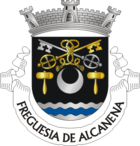Alcanena
| Alcanena | ||||||
|---|---|---|---|---|---|---|
|
||||||
| Basic data | ||||||
| Region : | Centro | |||||
| Sub-region : | Médio Tejo | |||||
| District : | Santarém | |||||
| Concelho : | Alcanena | |||||
| Coordinates : | 39 ° 28 ′ N , 8 ° 40 ′ W | |||||
| Residents: | 4158 (as of June 30, 2011) | |||||
| Surface: | 10.36 km² (as of January 1, 2010) | |||||
| Population density : | 401 inhabitants per km² | |||||
| politics | ||||||
| Mayor : | António Armando Frazão Silva ( PS ) | |||||
| Address of the municipal administration: | Junta de Freguesia de Alcanena Largo António Machado Baptista, n.º 6 2380-036 Alcanena |
|||||
| Alcanena district | ||||||
|
||||||
| Residents: | 13,868 (as of June 30, 2011) | |||||
| Surface: | 127.32 km² (as of January 1, 2010) | |||||
| Population density : | 109 inhabitants per km² | |||||
| Number of municipalities : | 7th | |||||
| administration | ||||||
| Administration address: | Câmara Municipal de Alcanena Praça 8 de Maio 2380-037 Alcanena |
|||||
| President of the Câmara Municipal: | Fernanda Maria Pereira Asseiceira ( PS ) | |||||
| Website: | www.cm-alcanena.pt | |||||
Alcanena is a small town in Portugal .
geography
Alcanena is about 50 km from the Atlantic Ocean to the west and about 30 km north of the district capital Santarém and 23 km south of the famous pilgrimage site of Fátima .
It is located in the north of the historical Ribatejo province , between the Santo António and Mira Daire caves , towards Fátima. The north of the district has been part of the Parque Natural das Serras de Aire e Candeeiros (PNSAC), the "Natural Park of the Mountains of Aire and Candeeiros" , since May 4, 1979 .
history
The origins of the place lie in the Arab settlement from the 8th century AD. In addition to the traditional skin processing and leather production, the place also owes its name to these origins. The two prevailing theories of derivation see Alcalina (roughly “dry head”) and al-Kinan (roughly “overshadowed place”) as the original Arabic place names.
During the Reconquista , Alcanena fell under D. Sancho I to the young kingdom of Portugal and was repopulated. In 1353 Alcanena existed again as a small place. In the royal surveys of 1527, the parish of Alcalena, Peral and Gouxaria had 40 households, which corresponded to about 200 people. In the registers of 1758 Alcalena was listed as a separate municipality in the Torres Novas district with 1067 inhabitants. The community continued to flourish. A sign of this was the population's demand for a fair , which was approved by the district administration on October 27, 1782 and set for June 29. In 1788 a weekly market was set up every Wednesday. From 1792 there is also a record of the first factory in Alcanena that manufactured soles and enjoyed government privileges under Prime Minister Marquês de Pombal .
The Napoleonic invasions at the beginning of the 19th century, which particularly raged in this region in front of the Torres Vedras lines around 1810 , but also the Liberal Revolution in 1822 and the subsequent Miguelistenkrieg were only temporary obstacles to the growth of the place. Between 1767 and 1867 doubled the population of Alcanenas almost. This also gave rise to the desire for independence for the community, which still belonged to Torres Novas. After the residents were partisans of the Liberals in the 1822 revolution, the emerging idea of a republic also became popular among them . The motto “For the country, the republic, for Alcanena the circle” (Portuguese: Para o País a República, para Alcanena o concelho ) spread here. After the Portuguese Republic was proclaimed in 1910, Alcanena became an independent district on May 8, 1914, when it was spun off from Torres Novas. At the same time it was elevated to a small town ( Vila ).
administration
The circle
Alcanena is the administrative seat of a district of the same name ( concelho ) in the Santarém district . On June 30, 2011 the district had 13,868 inhabitants on an area of 127.3 km².
The neighboring areas are (starting clockwise in the north): Batalha , Vila Nova de Ourém , Torres Novas , Santarém and Porto de Mós .
With the regional reform in September 2013, several municipalities were merged into new municipalities, so that the number of municipalities decreased from ten to seven.
The Alcanena district is made up of the following seven municipalities ( Freguesias ) :
| local community | Population (2011) |
Area km² |
Density of population / km² |
LAU code |
|---|---|---|---|---|
| Alcanena e Vila Moreira | 5.105 | 15.43 | 331 | 140211 |
| Bugalhos | 1,084 | 16.46 | 66 | 140202 |
| Malhou, Louriceira e Espinheiro | 1,909 | 34.46 | 55 | 140212 |
| Minde | 3,293 | 21.14 | 156 | 140206 |
| Moitas Venda | 866 | 6.75 | 128 | 140207 |
| Monsanto | 886 | 18.46 | 48 | 140208 |
| Serra de Santo António | 725 | 14.62 | 50 | 140209 |
| Alcanena district | 13,868 | 127.32 | 109 | 1402 |
Population development
| Population in the Alcanena district (1920–2011) | |||||||
|---|---|---|---|---|---|---|---|
| 1920 | 1930 | 1960 | 1981 | 1991 | 2001 | 2004 | 2011 |
| 10.207 | 11,122 | 14,773 | 14,287 | 14,373 | 14,600 | 14,763 | 13,884 |
Municipal holiday
- Ascension of Christ
Town twinning
-
 Santa Croce sull'Arno , Italy
Santa Croce sull'Arno , Italy -
 Les Mureaux , France
Les Mureaux , France -
 Sal , Cape Verde
Sal , Cape Verde
traffic
Long-distance transport
The connection to the A1 autobahn and the junction with the A23 autobahn, 4 km away, are the district's closest connections to the country's trunk road network. The national road N361 passes the place.
Alcanena is integrated into the national long-distance bus network of Rede Expressos .
The next rail connection is in Entroncamento, about 20 km to the east, with its connection to the Linha do Norte , the country's most important rail connection.
Local transport
Local public transport in the district is operated by private bus routes.
The district of Alcanena has a municipal road network of 360 km.
sons and daughters of the town
- Alfredo Roque Gameiro (1864–1935), painter
- João Querido Manha (* 1958), sports journalist, press officer of the Portuguese Olympic Committee from 2004 to 2009
- Adelaide Ferreira (* 1959), singer and actress
- Mila Ferreira (* 1962), singer
- Carlos Calado (* 1975), Olympic track and field athlete
- Marta Fernandes (* 1979), singer, actress and voice actress
- Rui Nereu (* 1986), football player
Web links
- Map of the Freguesia Alcanena at the Instituto Geográfico do Exército
- Official website of the city administration (port.)
- Photos from ALCANENA on Flickr
Individual evidence
- ↑ www.ine.pt - indicator resident population by place of residence and sex; Decennial in the database of the Instituto Nacional de Estatística
- ↑ a b Overview of code assignments from Freguesias on epp.eurostat.ec.europa.eu
- ↑ a b www.ine.pt - indicator resident population by place of residence and sex; Decennial in the database of the Instituto Nacional de Estatística
- ↑ a b Profile of the district of Alcanena on the website of the city administration ( memento of January 26, 2012 in the Internet Archive ), accessed on May 8, 2014
- ^ History of the district on the website of the city administration ( memento from January 26, 2012 in the Internet Archive ), accessed on May 14, 2014
- ^ Publication of the administrative reorganization in the Diário da República gazette of January 28, 2013, accessed on March 16, 2014
- ↑ www.anmp.pt , accessed on May 14, 2014










